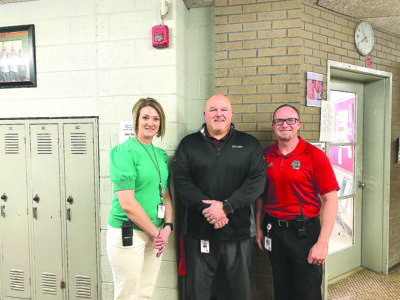Captina Conservancy makes room for native species plants at Dysart Woods

Dysart Woods land steward Marshall Dyer will lead volunteers to pull invasive species, including the multiflora rose shown here, from the woods to make room for native species. Photo Provided
BELMONT — The public is welcome to tag along with Captina Conservancy volunteers to pull invasive plants from the ground in Dysart Woods to make room for native species.
Dysart Woods Land Steward Marshall Dyer will be leading the crew for the first invasive species pull at 10 a.m. Saturday at 61919 Dysart Woods Road.
Dyer and those interested in helping will pull invasive species from the earth by hand. Extra gloves and some tools will be provided, but people are also welcome to bring their own gear.
Dyer said this is a chance for the people to go out to Dysart, which has been famous in the community for decades, and make room for native plants to grow in place of invasive species.
Two invasive species that volunteers will pull include the Japanese honeysuckle and multiflora rose. By pulling out these invasive species, people will make room for plants that grow naturally in North America.
Dyer said it’s important to pull out the invasive species because they came from another country, so they’re from a different kind of habitat. He said North America’s native plants are not adapted to compete with them.
“Normally, the invasive species will take hold and then reproduce like crazy and take up all of the sunlight and all of the space, and your native grasses and shrubs and trees, they can’t get started because there’s already something in its place,” he said.
At one time, farmers would plant the thorny bush multiflora rose that came from Asia instead of installing fence rows because they didn’t realize what it was and how it could spread. The bush likes to grow really fast, and it spreads out into the woods.
Dyer opened the invasive species pull to the public because he feels the community might not know much about these plants and how invasive and impactful they are to the habitat local people live in.
The autumn olive, another invasive species, is just a big silver, grayish bush that will take over a field in a year, Dyer said, because it grows berries that get absolutely everywhere and grow very quickly. If people don’t pull the sprouts, they will continue to spread and continue to grow, and eventually that land won’t be good for anything because it becomes covered in the bushes.
Only a few autumn olives reside on the property, so Dyer said he will take care of pulling them another day.
Dyer will start the event in the parking lot by providing some information for volunteers. He will have a sample of multiflora rose and a branch from Japanese honeysuckle to show them. He will show the leaf pattern of each species because they look different from native plants.
It has been a pretty warm spring, Dyer said, so invasive species tend to flower out before native plants do. If someone were to go into the woods right now, a lot of the green they would see in the woods are mainly invasive.
After pulling the plants, people will leave them where they pulled them, Dyer said, because the multiflora rose and Japanese honeysuckle haven’t developed seeds yet.
“The main thing would be to have a better understanding of the things that are outside, what’s good and what’s not,” Dyer said. “I really think there’s power in being able to identify the things that are outside and knowing whether it’s edible or not, or ‘Is that poison ivy, or can I touch it?’ It makes you more competent outside in the woods, and when you start looking for stuff that small and noticing little details, I think it makes you more efficient in life as well.”





